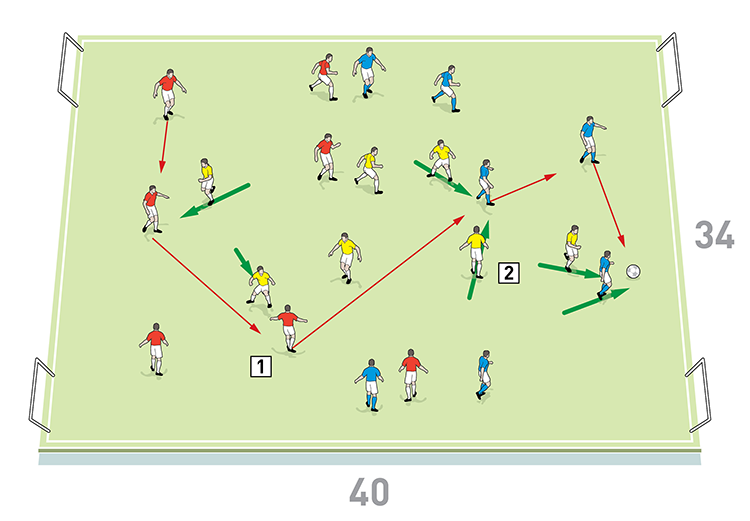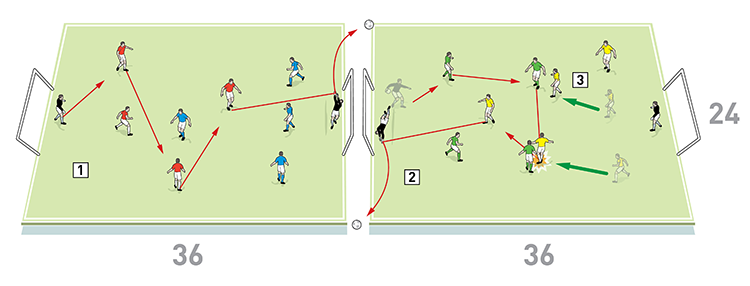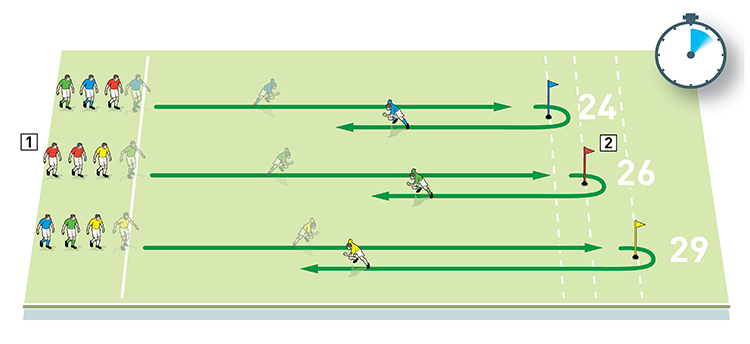Pressing & pre-season conditioning
| Area | Up to 40x34 yards |
| Equipment | Up to 21 players + 4 goalkeepers |
| No. of Players | Balls, bibs, cones, 4 mini goals, 4 full size goals |
| Session Time |
Box possession: 12mins Transitional possession: 26mins SSG & conditioning runs: 32mins |
This session is about pressing, with a focus on the transition after winning the ball, and it’s one that we specifically use in pre-season. We usually run it in week three of our pre-season training programme, when the content starts to switch to more football-specific conditioning activities.
It’s a session that helps to remind players of the tactical elements of pressing, whilst building the physical capacities that are required to perform this repeatedly at a high intensity.
Although we use this in pre-season, it’s a session that is consistent with our principles of play throughout the season.
What do I get the players to do?
Box possession
We set up an area of 7x7 yards. We’re using four players, split into a passing team of three and one pressing player. The passing team starts in possession and they must pass two balls between themselves under pressure from the defender, as shown [1]. If the pressing player wins possession of one of the balls, the game starts again. We rotate roles regularly, so everyone takes a turn as the pressing player – we usually make sure each player has two turns of 60 seconds in the pressing role with 30 seconds recovery between.
1

2. The sole blue defender presses and tries to win the ball. If he succeeds, the game starts again
How do I progress the practice?
Progress the Box Possession practice by playing 3v1 with just one ball instead of two, but limit the passing players to just one touch. In this progression, the player who loses the ball immediately swaps roles with the presser.
Transitional possession
We set up an area of 40x34 yards with two mini goals at each end. We’re using 21 players, split into three teams of seven. Two of the teams work together to keep possession, while the third team presses and attempts to get control of the ball, as shown [2a]. If possession is regained by the pressing team, they try to score in one of the four mini goals, as shown [2b].
2a

2. The yellows press and try to win possession
2b

2. After the first three games, we add a transitional element. After scoring, the yellow pressers would swap roles with the team that lost possession
We play three two-minute games in this format, with 90 seconds recovery time between games. Then we play another three two-minute games with a transitional element added – if the pressing team scores after winning possession, they swap roles with the team that lost possession.
How do I progress the practice?
Progress the Transitional Possession practice by changing two of the small goals to full-size goals with goalkeepers. The team that wins possession can now look to score in either the small or the full-size goals, but they must shoot within five passes.
How would you put this into a game situation?
Small-sided games & conditioning runs
We set up two adjacent areas of 36x24 yards with a goal at each end. We’re using 16 outfield players and four goalkeepers. Four teams compete to win a 5v5 tournament, with two games played at the same time, as shown [3]. Each team plays the other three teams once, scoring one point for a draw and three points for a win. The top two teams play each other in the final and the bottom two teams contest the third place play-off. Each game has a duration of four minutes.
3

2. Play a four-team tournament culminating in a final and a third-place play-off game
3. Between games the players should go on conditioning runs supervised by the fitness coach
Teams are given two minutes’ recovery between the first and second games. After the second game, all teams are sent to the fitness coaches who will complete conditioning runs with them.
Players should be seeded in three groups, and they are set targets of 24 yards, 26 yards, or 29 yards, depending on their speeds. Each group is given 10 seconds to get to the pole that marks their set distance and back to the start line, as shown [4]. They then repeat the run to their set distance eight times.
4

2. Each player performs eight repetitions before returning to the pitch to play their next small-sided game in the four-team tournament
After completion of the conditioning runs, the players have a further two minutes of recovery before starting the third game. These conditioning runs are repeated after the fourth game, with the session finishing after the last set of runs.
What are the key things to look out for?
When in possession we want to see technically good receiving skills, with players making quick one-touch passes and having the tactical nous to play away from pressure. We want to see teams switching play and controlling the tempo of possession. Additionally, we want to see players taking secure possession of the ball on transition.
Out of possession, we want to see effective pressing and good 1v1 defending. Players should demonstrate they can recognise pressing triggers and know when and how to press. We also want defenders to set pressing traps for their opponents.
Related Files
Editor's Picks
Attacking transitions
Deep runs in the final third
Using the goalkeeper in build-up play
Intensive boxes drill with goals
Penetrating the final third
Creating and finishing
My philosophy
Pressing initiation
Compact team movement
Coaches' Testimonials

Alan Pardew

Arsène Wenger

Brendan Rodgers

Carlos Carvalhal

José Mourinho

Jürgen Klopp

Pep Guardiola

Roy Hodgson

Sir Alex Ferguson

Steven Gerrard
Coaches' Testimonials

Gerald Kearney, Downtown Las Vegas Soccer Club

Paul Butler, Florida, USA

Rick Shields, Springboro, USA

Tony Green, Pierrefonds Titans, Quebec, Canada
Join the world's leading coaches and managers and discover for yourself one of the best kept secrets in coaching. No other training tool on the planet is written or read by the calibre of names you’ll find in Elite Soccer.
In a recent survey 92% of subscribers said Elite Soccer makes them more confident, 89% said it makes them a more effective coach and 91% said it makes them more inspired.
Get Monthly Inspiration
All the latest techniques and approaches
Since 2010 Elite Soccer has given subscribers exclusive insight into the training ground practices of the world’s best coaches. Published in partnership with the League Managers Association we have unparalleled access to the leading lights in the English leagues, as well as a host of international managers.
Elite Soccer exclusively features sessions written by the coaches themselves. There are no observed sessions and no sessions “in the style of”, just first-hand advice delivered direct to you from the coach.









